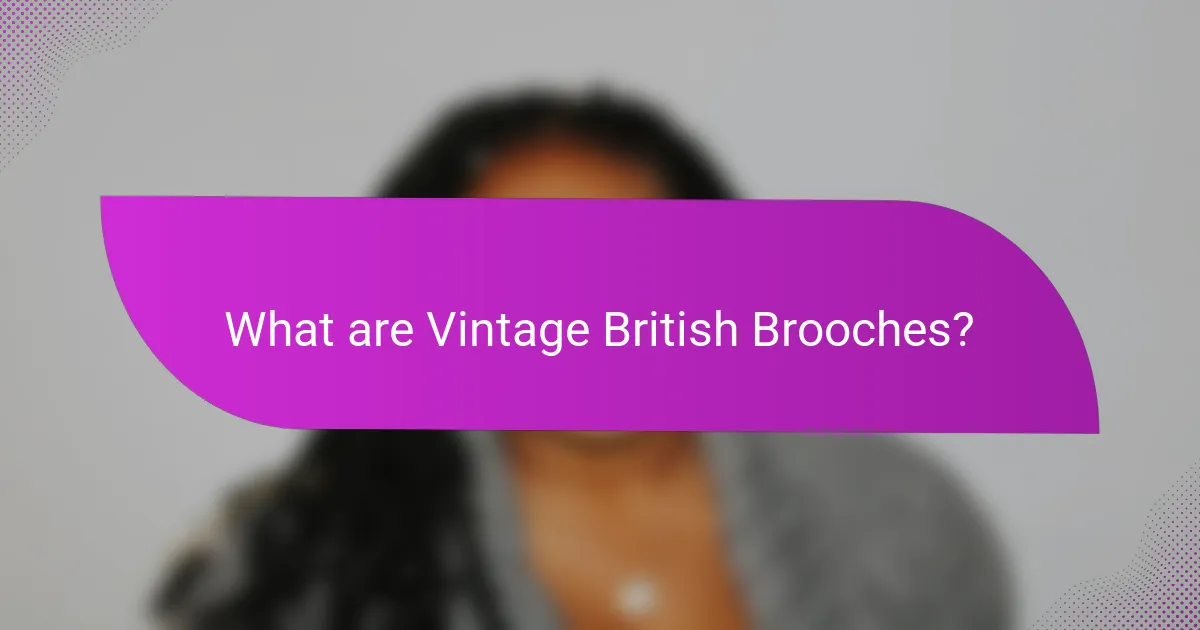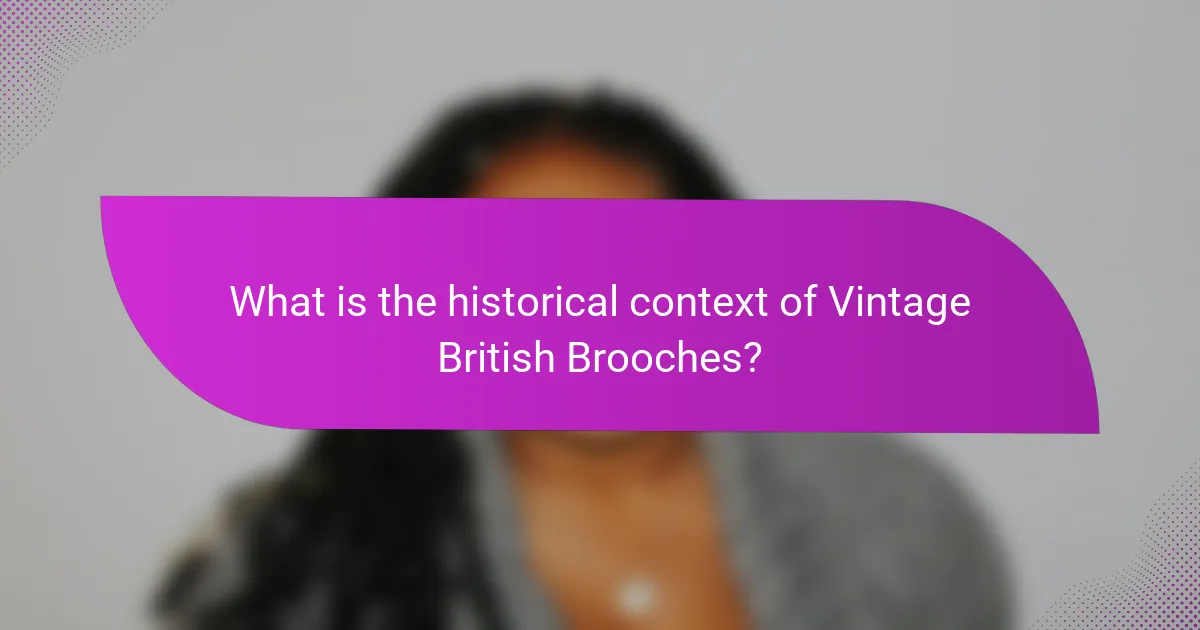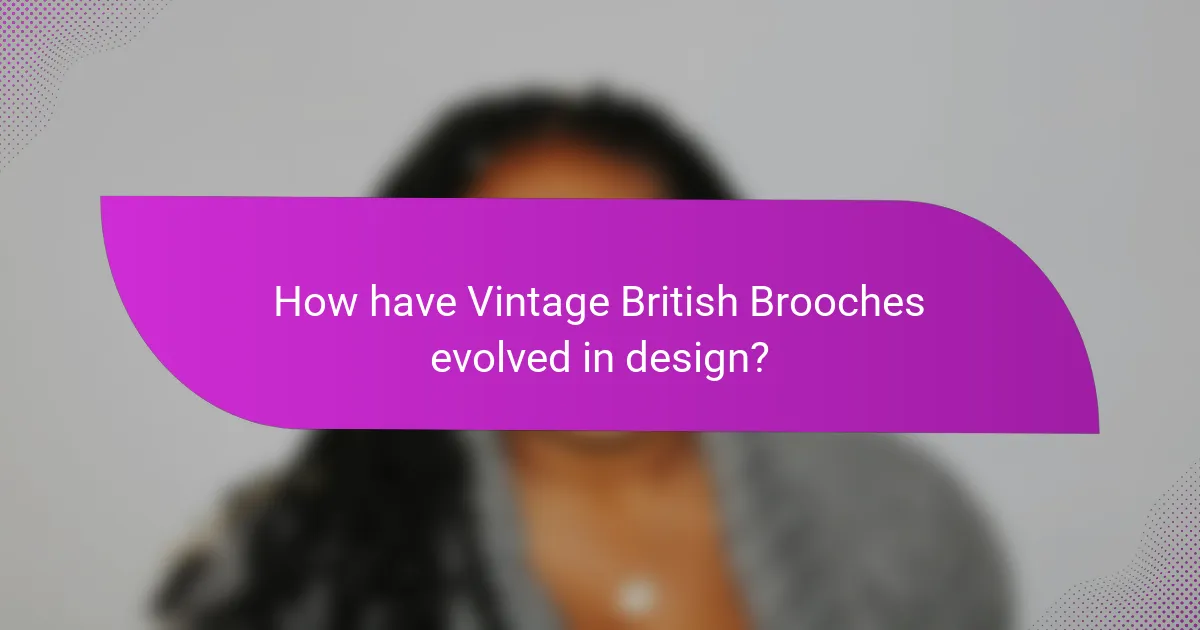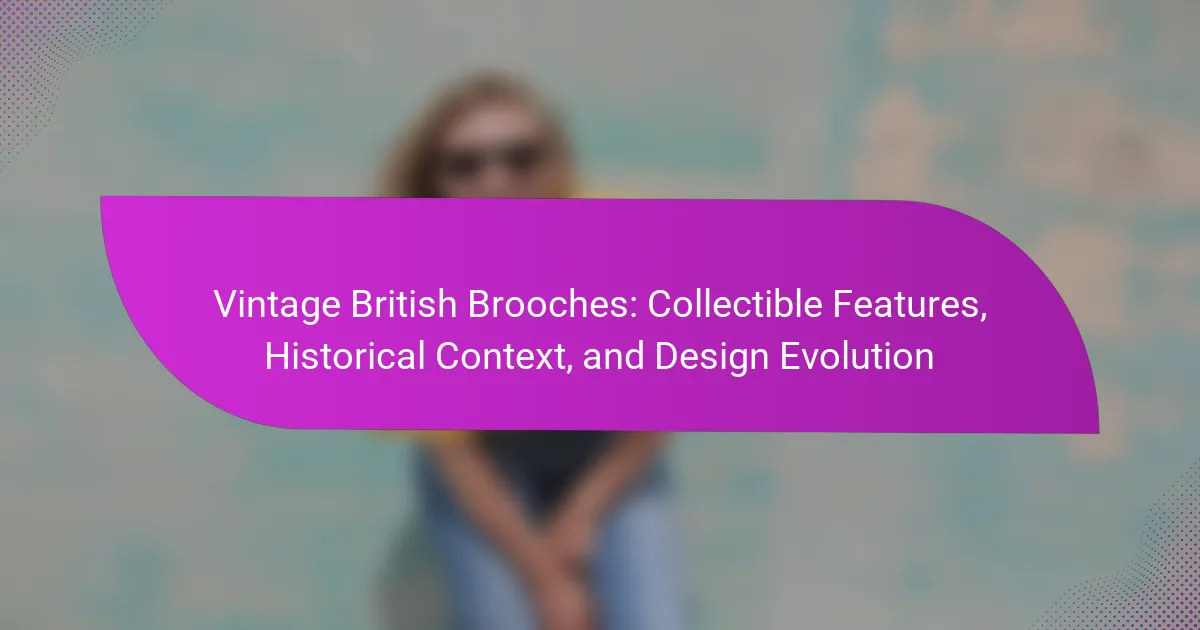Vintage British brooches are decorative jewelry pieces originating from Britain, predominantly crafted between the late 19th century and mid-20th century. These brooches are characterized by intricate designs influenced by artistic movements such as the Victorian, Art Nouveau, and Art Deco periods, often made from materials like gold, silver, and enamel, and embellished with gemstones. The article explores the historical context of these brooches, their evolution in design reflecting cultural shifts, and their significance as collectible items valued for their craftsmanship and rarity. Key themes include the role of brooches in personal expression, patriotism during wartime, and the impact of various artistic movements on their aesthetics.

What are Vintage British Brooches?
Vintage British brooches are decorative jewelry pieces that originated in Britain, typically made between the late 19th century and the mid-20th century. These brooches often feature intricate designs and craftsmanship, reflecting the artistic styles of their respective eras. Common materials used include gold, silver, and enamel, with gemstones frequently incorporated for added elegance. The Victorian, Art Nouveau, and Art Deco periods heavily influenced their design, showcasing motifs like floral patterns and geometric shapes. Collectors value these brooches for their historical significance and unique artistry. Many vintage British brooches are sought after at auctions and antique shops, often fetching high prices due to their rarity and craftsmanship.
How did Vintage British Brooches become popular?
Vintage British brooches became popular due to their unique designs and historical significance. Initially, they were worn as symbols of status and fashion in the Victorian era. The Arts and Crafts movement further influenced their intricate craftsmanship. Post-World War II, brooches saw a revival as women sought to express individuality. Collectors appreciate them for their artistic value and connection to British heritage. The rise of vintage fashion trends has also increased their desirability. Today, vintage British brooches are sought after in auctions and antique shops. Their popularity continues to grow as they represent a blend of history and style.
What historical events influenced the design of Vintage British Brooches?
The design of Vintage British Brooches was influenced by several historical events. The Victorian Era (1837-1901) saw a surge in intricate designs due to the Industrial Revolution. Advances in technology allowed for mass production and innovative techniques. The Arts and Crafts Movement in the late 19th century emphasized handmade craftsmanship, impacting brooch aesthetics. World War I and II influenced designs with patriotic themes and the use of alternative materials. The 1920s and 1930s introduced Art Deco styles, characterized by geometric shapes and bold colors. Each of these events shaped the artistic direction and materials used in brooch design.
How did social changes impact the production of Vintage British Brooches?
Social changes significantly impacted the production of Vintage British Brooches. The rise of women’s suffrage in the early 20th century led to increased female empowerment. This shift resulted in brooch designs that reflected women’s independence and style. Additionally, the post-war economic boom in the 1950s created a demand for luxury items. Manufacturers began producing more intricate and diverse brooch designs to cater to changing fashion trends. The influence of popular culture, including films and celebrities, also shaped consumer preferences. As a result, brooches became symbols of status and personal expression during this period.
What are the key features of Vintage British Brooches?
Vintage British brooches are characterized by intricate designs, diverse materials, and historical significance. They often feature floral motifs, animals, or abstract shapes. Common materials include gold, silver, enamel, and gemstones. Many brooches date back to the Victorian era, reflecting the craftsmanship of that time. Art Deco influences are also evident in some designs, showcasing geometric patterns. Collectors value these pieces for their uniqueness and artistry. Additionally, many brooches were made by renowned manufacturers, adding to their desirability. The combination of aesthetic appeal and historical context makes vintage British brooches highly collectible.
What materials are commonly used in Vintage British Brooches?
Vintage British brooches are commonly made from materials such as gold, silver, and various types of gemstones. Gold is often used for its durability and aesthetic appeal. Silver is another popular choice due to its malleability and shine. Gemstones like pearls, sapphires, and garnets are frequently incorporated for added elegance. Additionally, enamel is commonly used to provide color and intricate designs. These materials reflect the craftsmanship and style of the era. The use of these materials is evident in many notable vintage brooches from the Victorian and Edwardian periods.
How do the sizes and shapes of Vintage British Brooches vary?
Vintage British brooches vary significantly in both size and shape. Sizes range from small, delicate pieces measuring around 2-3 cm to larger statement brooches that can exceed 10 cm. Shapes include traditional motifs like flowers and leaves, as well as abstract and geometric designs. Some brooches feature intricate detailing, while others are simpler in form. The diversity in size and shape reflects the design trends of different eras, such as the Victorian, Art Nouveau, and Art Deco periods. For instance, Victorian brooches often showcased elaborate craftsmanship, while Art Deco pieces emphasized clean lines and symmetry. This variation makes vintage British brooches unique and collectible.

What is the historical context of Vintage British Brooches?
Vintage British brooches emerged prominently during the Victorian era, which lasted from 1837 to 1901. This period saw a rise in personal adornment as a reflection of social status and individual expression. Brooches became popular accessories, often crafted from precious metals and adorned with gemstones. The Arts and Crafts movement in the late 19th century influenced designs, emphasizing handcrafted artistry and natural motifs.
During World War I, brooches served as symbols of patriotism and remembrance. They were often designed to commemorate military service or honor loved ones. The post-war period brought a revival of opulence in jewelry, with brooches featuring intricate designs and a variety of materials.
The mid-20th century introduced modernist influences, leading to more abstract and geometric designs. Brooches became a canvas for artistic expression, reflecting contemporary trends. By the end of the century, vintage British brooches gained popularity among collectors, celebrated for their historical significance and craftsmanship.
Which eras are significant in the history of Vintage British Brooches?
The significant eras in the history of Vintage British Brooches include the Victorian, Edwardian, Art Nouveau, and Art Deco periods. The Victorian era, spanning from 1837 to 1901, saw brooches adorned with sentimental motifs and intricate designs. The Edwardian period, from 1901 to 1910, emphasized elegance and featured delicate filigree work. The Art Nouveau era, from 1890 to 1910, introduced organic forms and flowing lines in brooch designs. The Art Deco period, from the 1920s to the 1930s, showcased geometric shapes and bold colors. Each era reflects distinct artistic movements and societal influences in brooch craftsmanship.
What styles emerged during the Victorian era for brooches?
During the Victorian era, several distinctive styles emerged for brooches. Popular designs included the sentimental and romantic motifs, often featuring hearts or floral patterns. The use of naturalistic themes became prominent, showcasing intricate representations of flowers and leaves. Mourning jewelry also gained popularity, incorporating materials like jet and onyx. Additionally, the introduction of the cameo brooch offered a classical aesthetic, depicting profiles carved in relief. The use of gemstones and intricate metalwork defined many Victorian brooches. Each style reflected the social values and artistic trends of the time, emphasizing craftsmanship and personal expression.
How did the Art Deco movement influence brooch design?
The Art Deco movement significantly influenced brooch design through its emphasis on geometric shapes and bold colors. This design style emerged in the 1920s and 1930s, characterized by a departure from the ornate styles of previous eras. Art Deco brooches often featured streamlined forms and symmetry, reflecting the era’s fascination with modernity and technology. Materials such as enamel, diamonds, and colored gemstones were commonly used to create striking contrasts. Additionally, motifs inspired by nature, architecture, and cultural elements were prevalent in these designs. The movement’s impact is evident in the popularity of brooches that combined artistic expression with functionality. Art Deco brooches remain highly collectible today, demonstrating the enduring legacy of this influential design movement.
What role did famous designers play in the evolution of Vintage British Brooches?
Famous designers significantly influenced the evolution of Vintage British Brooches. Their innovative designs introduced new styles and materials. Designers like Kenneth Jay Lane and Andrew Grima redefined brooch aesthetics in the mid-20th century. They incorporated bold colors and unconventional shapes. This shift reflected broader fashion trends of the era. The handcrafted nature of their pieces added uniqueness. Additionally, collaborations with jewelry houses enhanced the prestige of vintage brooches. The impact of these designers is evident in the lasting popularity of their creations. Their work established a legacy that continues to inspire contemporary jewelry design.
Who are some notable designers associated with Vintage British Brooches?
Notable designers associated with Vintage British Brooches include Kenneth Jay Lane, who was renowned for his bold and glamorous designs. Another significant designer is David Andersen, known for his intricate enamel work. Additionally, the brand Ciner produced exquisite vintage brooches that are highly collectible. These designers contributed to the popularity of brooches in the mid-20th century. Their unique styles and craftsmanship have made their pieces sought after by collectors today.
What innovations did these designers introduce?
The designers of vintage British brooches introduced several key innovations. They incorporated new materials like enamel and semi-precious stones. This expanded the aesthetic appeal of brooches. They also developed techniques such as cloisonné and filigree work. These methods enhanced the intricacy of designs. Additionally, designers began to use themes from nature and mythology. This added a narrative element to the pieces. The introduction of abstract forms marked a shift in design philosophy. These innovations collectively transformed brooches into wearable art.

How have Vintage British Brooches evolved in design?
Vintage British brooches have evolved significantly in design over the years. Initially, during the Victorian era, brooches featured intricate floral motifs and sentimental themes. The Art Nouveau period introduced more organic shapes and flowing lines, emphasizing nature-inspired designs. In the 1920s, Art Deco brought geometric patterns and bold colors, reflecting modernity and luxury. Post-World War II designs often incorporated patriotic symbols and materials like plastic. The 1960s and 1970s saw a rise in whimsical and playful designs, often featuring pop culture references. Today, vintage British brooches are celebrated for their craftsmanship and historical significance, appealing to collectors and fashion enthusiasts alike. This evolution showcases the changing tastes and cultural influences over time.
What are the different styles of Vintage British Brooches?
Vintage British brooches come in several distinct styles. These styles reflect various historical periods and design movements. Common styles include Art Nouveau, characterized by organic forms and flowing lines. Art Deco brooches feature geometric shapes and bold colors. Victorian brooches often showcase intricate designs with sentimental motifs. Additionally, there are styles influenced by the Edwardian era, known for their elegance and use of pearls and diamonds. Each style carries unique attributes that appeal to collectors. The diversity in design illustrates the rich history of British jewelry making.
How do floral and nature-inspired designs differ in brooches?
Floral designs in brooches focus specifically on flowers, showcasing their shapes and colors. Nature-inspired designs encompass a broader range of elements, including leaves, animals, and landscapes. Floral brooches often feature intricate detailing of petals and blossoms, emphasizing botanical aesthetics. In contrast, nature-inspired brooches may incorporate various textures and forms to represent diverse aspects of nature. Floral designs tend to evoke a romantic or delicate feel, while nature-inspired designs can convey a more rugged or organic essence. Both styles reflect the natural world, but the specific focus distinguishes them. Historical trends show floral designs were particularly popular during the Victorian era, while nature-inspired styles gained prominence in the Art Nouveau movement.
What is the significance of geometric patterns in brooch design?
Geometric patterns in brooch design are significant for their aesthetic appeal and cultural symbolism. These patterns often reflect the artistic movements of their time, such as Art Deco and Bauhaus. The use of geometric shapes can convey elegance and modernity. Historical context shows that geometric designs became popular in the early 20th century, aligning with advancements in design and manufacturing. Additionally, geometric patterns can enhance the visual impact of a brooch, making it a focal point of an outfit. Collectors often seek these designs for their unique characteristics and historical relevance. The distinctiveness of geometric patterns contributes to the overall value and desirability of vintage British brooches.
How do modern interpretations of Vintage British Brooches compare to historical ones?
Modern interpretations of Vintage British Brooches often emphasize contemporary design and personal expression. Historical brooches typically featured intricate craftsmanship and were often made from precious materials. Today, many modern brooches incorporate mixed media and unconventional materials, reflecting current fashion trends.
Historically, brooches served both decorative and functional purposes, often symbolizing status or affiliation. In contrast, modern interpretations prioritize aesthetic appeal and individuality over traditional meanings.
While vintage pieces often showcased traditional motifs and techniques, contemporary designs may reinterpret these elements in innovative ways. For example, modern brooches may simplify forms or use bold colors that differ from historical palettes.
This evolution illustrates a shift from the opulence of the past to a more eclectic and personal approach in today’s fashion landscape.
What contemporary trends are influencing brooch designs today?
Contemporary trends influencing brooch designs today include a focus on sustainability, personalization, and bold aesthetics. Designers are increasingly using eco-friendly materials to appeal to environmentally conscious consumers. Personalization allows wearers to express individuality through custom designs and unique features. Bold aesthetics are characterized by oversized shapes and vibrant colors, reflecting modern fashion sensibilities. Additionally, the blending of vintage styles with contemporary elements creates a unique fusion in brooch designs. This trend is evident in collections that incorporate historical motifs with modern materials and techniques. Overall, these trends reflect the evolving tastes and values of today’s consumers in the fashion jewelry market.
How are vintage styles being revived in modern fashion?
Vintage styles are being revived in modern fashion through the incorporation of retro designs and materials. Designers often draw inspiration from past decades, particularly the 1920s to 1980s. This revival is evident in clothing, accessories, and jewelry, including vintage British brooches. Social media platforms showcase vintage aesthetics, influencing consumer preferences. Additionally, sustainable fashion trends encourage the use of second-hand and vintage items. Fashion weeks frequently feature collections that celebrate vintage elements. The popularity of thrift shopping has surged, with consumers seeking unique vintage pieces. This trend reflects a broader cultural appreciation for nostalgia and heritage in contemporary style.
What should collectors consider when acquiring Vintage British Brooches?
Collectors should consider the authenticity and provenance of Vintage British Brooches. Verifying the maker’s mark is essential for establishing authenticity. Researching the historical context can provide insights into the brooch’s significance. Condition plays a critical role; collectors should inspect for damage or repairs. Rarity influences value, so knowing production numbers is important. Materials used, such as gold or enamel, affect desirability. Understanding design trends can enhance appreciation of the piece. Lastly, market demand fluctuates, so staying informed on current trends is beneficial.
How can collectors authenticate Vintage British Brooches?
Collectors can authenticate Vintage British Brooches by examining several key features. First, they should check for maker’s marks or hallmarks. These marks often indicate the manufacturer and provide insights into the brooch’s origin. Secondly, collectors should assess the materials used. Vintage brooches often feature materials like sterling silver or gold, which can signify authenticity.
Additionally, collectors should compare the design and craftsmanship to known examples from reputable sources. Authentic vintage pieces typically display high-quality workmanship. They should also research historical context, as certain styles correspond to specific periods or designers.
Finally, consulting with experts or appraisers can provide further validation. Experts can offer insights based on their experience and knowledge of the market. Collectors can also refer to established guides and databases that document vintage brooches and their characteristics.
What are the best practices for maintaining and displaying Vintage British Brooches?
To maintain and display Vintage British Brooches, keep them clean and store them properly. Use a soft cloth to gently wipe the surface. Avoid using harsh chemicals that could damage the finish. Store brooches in a cool, dry place to prevent tarnishing. Use padded boxes or fabric pouches to avoid scratches. Display them away from direct sunlight to prevent fading. Arrange them in a way that avoids pressure on any pin mechanisms. Regularly check for loose stones or clasps to ensure they remain secure. These practices help preserve their condition and value over time.
Vintage British brooches are decorative jewelry pieces crafted primarily between the late 19th century and mid-20th century, showcasing intricate designs influenced by historical movements such as Victorian, Art Nouveau, and Art Deco. The article explores their popularity, historical context, and the social changes that impacted their production, as well as key features like materials, sizes, and styles. Additionally, it examines the evolution of brooch designs, the role of notable designers, and contemporary trends reviving vintage aesthetics, providing collectors with insights on authentication and maintenance. Overall, the piece highlights the significance of these brooches as collectible items that reflect British heritage and craftsmanship.
